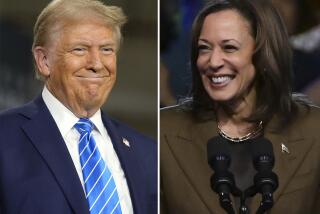Governor Races Seen as 1990 Main Event : Politics: Winners will have big voice in how their states are reapportioned. To make gains in House, GOP needs to take some posts away from rivals.
WASHINGTON — When Democrats at last month’s National Governors’ Conference grumbled that their party was letting President Bush off the hook too often, New Jersey’s James J. Florio had a ready rejoinder:
“Republicans have been playing pin-the-tail-on-the-donkey,” Florio said. “Now, it’s time to pin the tail on the elephant.”
On that militant note, the Democrats mounted a surprise offensive at the ostensibly nonpartisan conclave, issuing a call for a blue-ribbon commission to investigate the savings and loan scandal, which they hope to turn into a major liability for Republicans. Caught off guard, the Republicans protested--in vain.
It was no accident that this partisan skirmishing among the governors flared just as the 1990 campaign was getting under way. With little change in prospect for either the House or Senate, it is the governors’ races that politicians view as the main event of this midterm election, likely to have a far-reaching impact on the balance of power between the two parties for the rest of the century.
This November, the national census and the subsequent reapportionment of the House of Representatives coincide with reelection time for the majority of state chief executives--36 of them--a circumstance that occurs only once every 20 years. The governors who are elected this November will have a major influence on reapportionment.
At present, Democrats are in history’s driver’s seat, because they control 28 of the 50 governorships, along with most state legislatures. To prevent the Democrats from using the states’ reapportionment machinery to consolidate their hold on the House, unbroken for nearly 40 years, Republicans must wrest away some of the Democratic governorships while maintaining their own control of certain key states.
At the same time, the shift of responsibility away from Washington and to the states for many key domestic problems in recent years has made state capitals the center for new ideas--and political power--on such issues.
“The action is not going to be taking place in this town in the ‘90s,” Michelle Davis, Washington-based executive director of the Republican Governors’ Assn., contends. “The real action is going to be in Sacramento and Lincoln and St. Paul.”
By far the most strategically important contests are in the nation’s three fastest-growing states--California, Florida and Texas--which together are expected to gain up to 15 new House seats next year, giving them more than 100 of the chamber’s 435 members.
All three of these states now have Republican governors who are scheduled to leave office. Unless other Republicans take their places, the redistricting in those states probably will be controlled by Democrats, who currently have majorities in all three state legislatures.
Here is a brief look at these contests:
CALIFORNIA: The state’s 45-member House delegation is expected to increase to 52. Both parties consider the contest between Democrat Dianne Feinstein, former mayor of San Francisco, and Republican Sen. Pete Wilson to be even--and likely to remain close until Election Day.
Democrats are counting on Feinstein’s warmth and dynamism, which even Republicans admire. Even so, Republicans expect to gain votes because of Feinstein’s alleged overspending--and overtaxing--in San Francisco and because of her promise to appoint women and minority members to jobs according to their proportions in the population--which the GOP contends amounts to a quota system.
FLORIDA: This increasingly Republican state, whose 19-member House delegation is expected to grow by three or four next year, ironically offers Democrats their best opportunity for victory of all the big Sun Belt states.
Republican Gov. Bob Martinez, a former Democrat, hurt himself early in his first term by pushing through an unpopular tax on services--such as legal fees and advertising commissions. Later, he proposed tough anti-abortion legislation that foundered, adding to his political problems.
The likely Democratic candidate, former Sen. Lawton Chiles, leads Martinez in the polls. But Chiles has been losing ground to his opponent in the September primary, Rep. Bill Nelson, because of questions about his personal finances and his use of an anti-depressant drug.
TEXAS: The Lone Star State is considered the most likely of the Big Three to remain in Republican hands--despite the unpopularity of incumbent Gov. Bill Clements, who chose not to seek another term. Texas’ 25-member House contingent is likely to grow to 28 or 29.
Helped by an early massive television blitz, GOP standard-bearer Clayton W. Williams Jr. gained a lead in the polls, which he continues to maintain, despite some well-publicized gaffes--such as a joking reference to rape and the disclosure of his youthful visits to brothels.
Strategists for Democratic nominee Ann Richards, the state treasurer, are hoping to dig up enough negative information about Williams’ free-wheeling past to discredit him. But, so far, Richards has had trouble establishing a positive theme of her own.
However, the Sun Belt states aside, the Democrats have the most to lose in the governors’ races. They hold 20 of the 36 governorships being contested. And, in eight of these, the Democratic incumbents are not seeking reelection--providing easier targets for the GOP.
More to Read
Get the L.A. Times Politics newsletter
Deeply reported insights into legislation, politics and policy from Sacramento, Washington and beyond. In your inbox three times per week.
You may occasionally receive promotional content from the Los Angeles Times.










